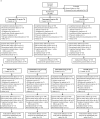Efficacy, General Safety, and Joint Safety of Tanezumab in Japanese Patients with Osteoarthritis: Subgroup Analyses from Two Randomized, Phase 3 Studies
- PMID: 35538185
- PMCID: PMC9314481
- DOI: 10.1007/s40122-022-00384-y
Efficacy, General Safety, and Joint Safety of Tanezumab in Japanese Patients with Osteoarthritis: Subgroup Analyses from Two Randomized, Phase 3 Studies
Abstract
Introduction: Tanezumab is a monoclonal antibody against nerve growth factor that is under investigation for the treatment of osteoarthritis (OA) pain. We conducted subgroup analyses of two randomized phase 3 studies to summarize efficacy, general safety, and adjudicated joint safety of tanezumab in Japanese patients with moderate-to-severe OA.
Methods: In Study 1 (NCT02528188), patients received subcutaneous tanezumab 2.5 mg or 5 mg every 8 weeks or daily oral nonsteroidal anti-inflammatory drugs (NSAID) for 56 weeks. The co-primary efficacy endpoints were change from baseline in the Western Ontario and McMaster Universities Osteoarthritis Index (WOMAC) Pain subscale score and WOMAC Physical Function subscale score at Week 16 (overall study and Japan-specific endpoints) as well as Patient Global Assessment (PGA)-OA score at Week 16 (overall study endpoint only). In Study 2 (NCT02709486), patients received subcutaneous tanezumab 2.5 mg, 5 mg, or placebo every 8 weeks for 24 weeks. Safety monitoring included adjudicated composite joint safety endpoint (CJSE) including rapidly progressive osteoarthritis type 1 (RPOA1), RPOA2, primary osteonecrosis, pathological fracture, or subchondral insufficiency fracture.
Results: For Study 1, Japanese patients (n = 200) treated with tanezumab 2.5 mg and 5 mg showed numerically greater improvements in WOMAC Pain, WOMAC Physical Function, and PGA-OA scores versus NSAID at Week 16. Incidences of treatment-emergent adverse events were generally similar between tanezumab 2.5 mg, 5 mg, and NSAID groups. In the integrated safety analysis (Studies 1 + 2; n = 306), ten patients were adjudicated to have a component of CJSE: RPOA1 [tanezumab 2.5 mg (n = 2), tanezumab 5 mg (n = 5)], RPOA2 [tanezumab 2.5 mg (n = 1), tanezumab 5 mg (n = 1)], or primary osteonecrosis [tanezumab 2.5 mg (n = 1)]. Time-adjusted adjudicated rates of RPOA1 and RPOA2 were higher with tanezumab than NSAID or placebo and increased with dose of tanezumab.
Conclusion: Observations from the Japanese subgroup were generally consistent with the overall study populations.
Keywords: Joint safety; Osteoarthritis; PGA-OA; Pain measurement; Rapidly progressive osteoarthritis; Tanezumab; Treatment outcome; WOMAC pain and physical function.
© 2022. The Author(s).
Figures

Similar articles
-
Characterization of adverse joint outcomes in patients with osteoarthritis treated with subcutaneous tanezumab.Osteoarthritis Cartilage. 2023 Dec;31(12):1612-1626. doi: 10.1016/j.joca.2023.08.010. Epub 2023 Aug 29. Osteoarthritis Cartilage. 2023. PMID: 37652258
-
Observed efficacy and clinically important improvements in participants with osteoarthritis treated with subcutaneous tanezumab: results from a 56-week randomized NSAID-controlled study.Arthritis Res Ther. 2022 Mar 29;24(1):78. doi: 10.1186/s13075-022-02759-0. Arthritis Res Ther. 2022. PMID: 35351194 Free PMC article. Clinical Trial.
-
Long-Term Safety and Efficacy of Subcutaneous Tanezumab Versus Nonsteroidal Antiinflammatory Drugs for Hip or Knee Osteoarthritis: A Randomized Trial.Arthritis Rheumatol. 2021 Jul;73(7):1167-1177. doi: 10.1002/art.41674. Epub 2021 Jun 7. Arthritis Rheumatol. 2021. PMID: 33538113 Clinical Trial.
-
Efficacy and safety of tanezumab administered as a fixed dosing regimen in patients with knee or hip osteoarthritis: a meta-analysis of randomized controlled phase III trials.Clin Rheumatol. 2021 Jun;40(6):2155-2165. doi: 10.1007/s10067-020-05488-4. Epub 2020 Nov 6. Clin Rheumatol. 2021. PMID: 33159281 Review.
-
Tanezumab for Patients with Osteoarthritis of the Knee: A Meta-Analysis.PLoS One. 2016 Jun 13;11(6):e0157105. doi: 10.1371/journal.pone.0157105. eCollection 2016. PLoS One. 2016. PMID: 27294371 Free PMC article. Review.
References
-
- OARSI. Current status of and prospects for osteoarthritis treatment—development of Japanese OA guidelines based on OARSI part 2. 2011. https://oarsi.org/education/oarsi-resources/current-status-and-prospects.... Accessed 02 Feb 2022.
LinkOut - more resources
Full Text Sources

